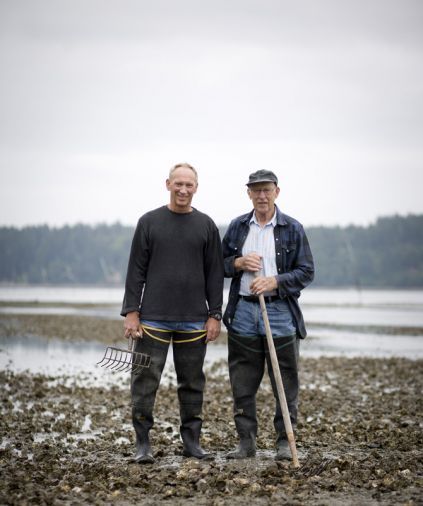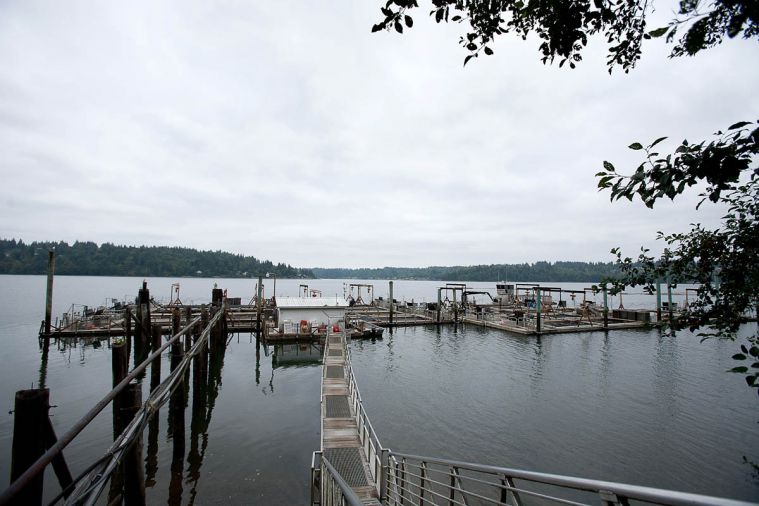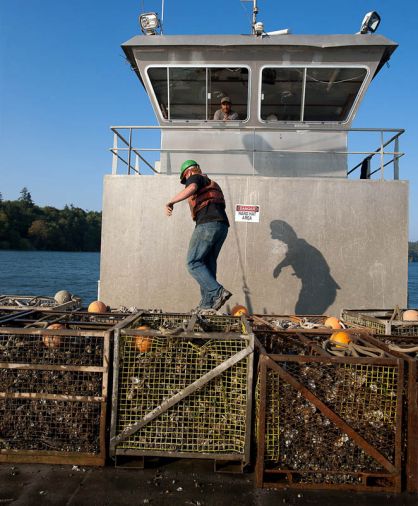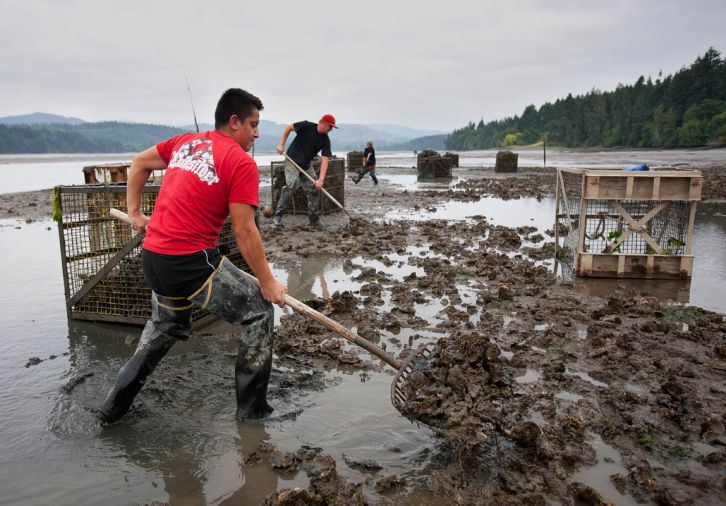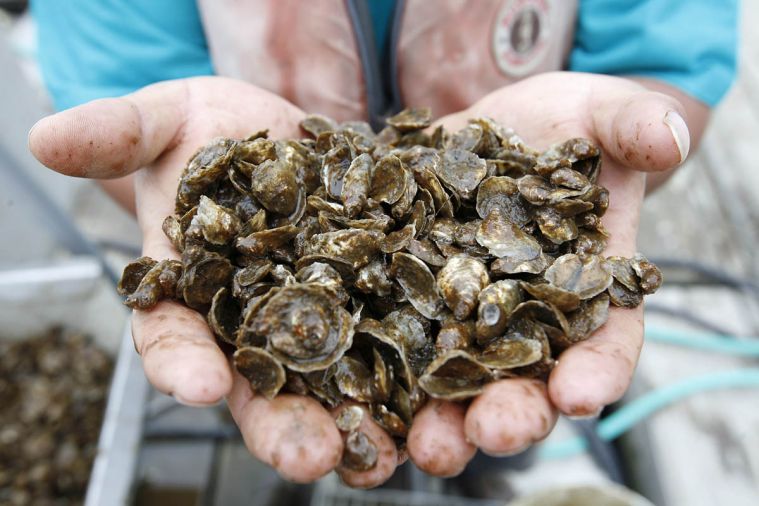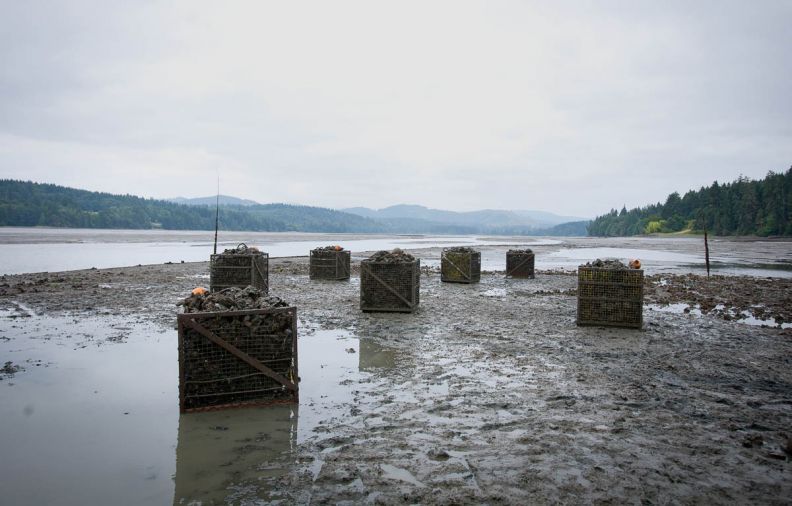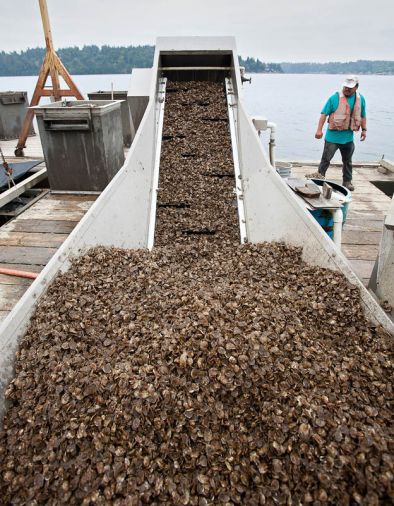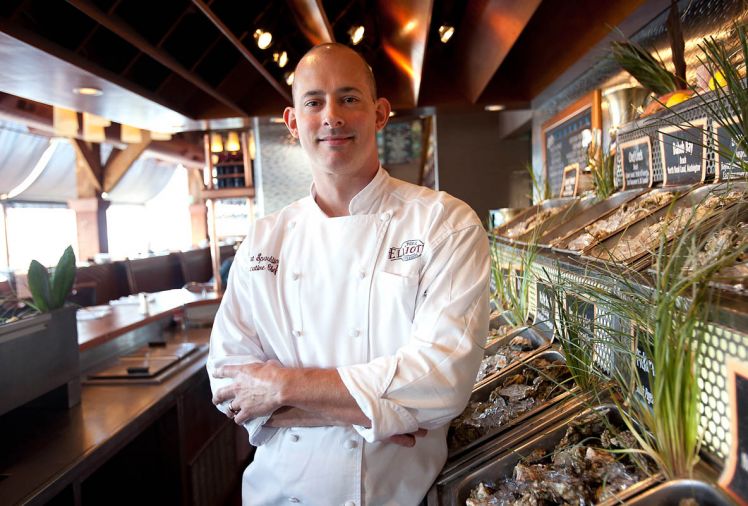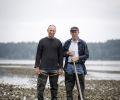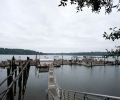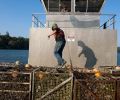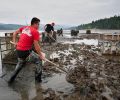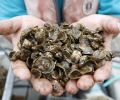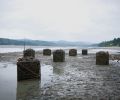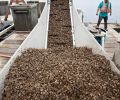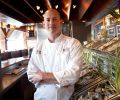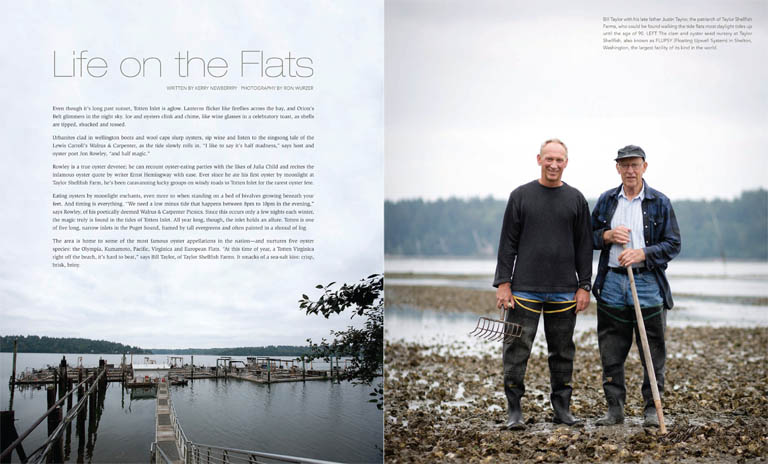Even though it’s long past sunset, Totten Inlet is aglow. Lanterns flicker like fireflies across the bay, and Orion’s Belt glimmers in the night sky. Ice and oysters clink and chime, like wine glasses in a celebratory toast, as shells are tipped, shucked and tossed.
Urbanites clad in wellington boots and wool caps slurp oysters, sip wine and listen to the singsong tale of the Lewis Carroll’s Walrus & Carpenter, as the tide slowly rolls in. “I like to say it’s half madness,” says host and oyster poet Jon Rowley, “and half magic.”
Rowley is a true oyster devotee; he can recount oyster-eating parties with the likes of Julia Child and recites the infamous oyster quote by writer Ernest Hemingway with ease. Ever since he ate his first oyster by moonlight at Taylor Shellfish Farm, he’s been caravanning lucky groups on windy roads to Totten Inlet for the rarest oyster fete.
Eating oysters by moonlight enchants, even more so when standing on a bed of bivalves growing beneath your feet. And timing is everything. “We need a low minus tide that happens between 8pm to 10pm in the evening,” says Rowley, of his poetically deemed Walrus & Carpenter Picnics. Since this occurs only a few nights each winter, the magic truly is found in the tides of Totten Inlet. All year long, though, the inlet holds an allure. Totten is one of five long, narrow inlets in the Puget Sound, framed by tall evergreens and often painted in a shroud of fog.
The area is home to some of the most famous oyster appellations in the nation—and nurtures five oyster species: the Olympia, Kumamoto, Pacific, Virginica and European Flats. “At this time of year, a Totten Virginica right off the beach, it’s hard to beat,” says Bill Taylor, of Taylor Shellfish Farms. It smacks of a sea-salt kiss: crisp, brisk, briny.
A hallowed ground for oysters, the south Puget Sound is fed by seasonal freshwater from the Olympic and Cascade Mountain watersheds. The ample fresh water that runs into the Puget Sound basin, boosts the production of algae. Oysters grow quickly, thriving in this algae-rich water; the result is a crisp, firm, full oyster.
In his book, “A Geography of Oysters,” author Rowan Jacbosen calls Washington state “oyster nirvana.” It’s the perfect confluence of geography, geology and climate, creating ideal growing conditions for high quality oysters. “Nowhere else possesses such an amazing jumble of landscapes, of oyster species, and of nuanced oysters,” writes Jacobsen.
Similar to wine grapes, oysters reflect the taste of where they are grown. This taste of place in wine is called terroir, a French word that loosely encapsulates land, soil, aspect and weather. For oysters, the essence of place is merroir, a term coined by shellfish guru Jon Rowley.
Bill Taylor, of Taylor Shellfish Farms, is deeply rooted to place, here in the south Puget Sound. “Our family has been in the oyster business for about 120 years,” he says. The Taylor legacy reads like a Wild West tale. The story begins with his great grandfather, who tried his hand at everything from ranching with Wyatt Earp in Arizona to searching for gold in Alaska.
Luckily, the elder Taylor landed in Washington in the 1890s and began farming the tiny Olympia oyster, the only oyster native to the West Coast. Today, Bill and his brother Paul, along with their brother-in-law Jeff Pearson, are the fourth generation of his family to run Taylor Shellfish Farms, the largest producer of shellfish in the United States.
The modest headquarters sits in the tiny town of Shelton, Washington, near Totten Inlet, where Bill and his brother began working the mudflats at the ages of five and seven. “We always enjoyed the activity and being outside,” says Taylor. At that time, most of the families living on the bay were shellfish farmers.
When Taylor speaks of the other shellfish growers in the area, he smiles when he recounts that most of them share great grandfathers who were also farmers of the tidelands. The business is an art built on legacy.
“A lot has been passed down from generation to generation,” says Bill, “and is learned from going out and working with your dad or grandfather,” he says. Like any work of passion, oyster farming falls into the lifestyle category, and demands commitment. The life of a shellfish farmer is dictated by the tides. In the heart of winter, “the low tides are all at night, so you are out working at midnight,” he says, “your life is very different from most other people.”
An alliance grows when you work a piece of land from dawn to dusk, from youth to adulthood. “You develop special connections to places you work,” says Bill. In college, a friend convinced Bill to travel around South America for a few months. The classmates worked six months prior digging clams in “Chapman’s Cove” to afford the trip.
The year was 1975, and the bay was degraded from pulp mill pollution. “Now I go back and look at the beach and I’ve been able to see that area really heal itself over the past 30 to 40 years,” he says. “You gain an enhanced appreciation for those areas.”
Bill and his brother Paul returned to the family business after college, in the early 1980’s, when shellfish hatcheries were starting to become commercially viable, before that, the business was built on harvesting what nature provided. In 1990, Taylor Shellfish built their first hatchery, which transformed opportunities, moving from gatherer to farmer.
Most Taylor Shellfish oysters begin in hatcheries, one in Quilcene, Washington and the other in Kona, Hawaii. Between the two spots, Taylor Shellfish raises seven billion oyster larvae annually. The role of the hatchery is to provide the perfect conditions for male and female oyster to spawn.
The baby oysters are shipped to farms in bundles about the size of a large baseball. Each bundle, resembling a black ball of sand, is equal to about ten million baby oysters. Once released into temperature controlled tanks; they will tap around, seeking a suitable substrate to attach to—in this case, a recycled oyster shell. Depending on the time of year, the farmer will move the oysters into the bay, where they will feed on a variety of rich micronutrients and grow. The average growing cycle spans three to five years, and varies by oyster species. The business of oyster farming is sustainable business and good for the environment.
Oysters are filter feeders. As they consume tiny plankton, they filter their food from water, improving water quality. The bivalves not only help clean the water, they are dependent upon the water being clean. For these reasons, it’s very ingrained in the oyster industry to act as environmental advocates. Each generation in the Taylor family has encountered environment-related challenges along the way.
“Water quality is a major issue for us,” says Bill. In the 1980s water quality in the bay was tainted by local pulp mill pollution; current issues are tied to ocean acidification, a much broader, far-reaching, global challenge. The industry has been collaborative both within itself and with the academic community, says Bill, when speaking of their cohesive voice on environmental issues. “A rising tide raises all boats,” he says. In addition to facing challenges together, the industry works jointly on advancing technologies.
“Everyone has an open door policy,” says Bill. If someone wants to come learn something about the way we do things, we say “come on over.” He pauses, and then says: “I think we are one of the more collaborative industries. A lot of us share ideas on a regular basis.”
With each new generation, the industry continues to thrive. The Taylor’s are already welcoming a fifth generation to the family business. Bill’s niece, Marcelle, recently moved from Los Angeles to help launch a new oyster bar in Seattle. “I sit in an office with my two uncles and my dad, my sister and my cousin,” says Marcelle. “Nothing beats that.” All of the Taylor generations concur on the allure of the oyster. “There’s an intriguing part of shellfish that people want more of,” says Marcelle. “It’s such a family, communal food,” she adds, “you share this platter in the middle of the table, and it brings people together.”
Eating a raw oyster is akin to food ritual: the lift of the shell, the slight tilt, the kiss of lips, splash of sea-salt, taste of place. Poet Seamus Heaney captured their essence best when he wrote: “My tongue was a filling estuary / My palate hung with starlight / As I tasted the salty Pleiades / dipped his foot into the water.” It’s a sensual reminder to slow down in a world that moves so fast.
TOTTEN INLET
By Rowan Jacobsen, A Geography of Oysters: The Connoisseur's Guide to Oyster Eating in North America
The two most famous appellations in south Puget Sound are Totten Inlet and Little Skookum Inlet, and since Little Skookum is actually a tributary of Totten, the two often are thought of interchangeably. Both have seriously algae-thick waters, leading to market-sized oysters in a year or less. But differences exist. While Little Skookum is basically a creek bed that fills at high tide, Totten is ninety feet deep in places and much more a creature of the sea. It produces oysters with the rich seaweedy flavor South Sound is famous for, but a bit saltier and less earthy than Little Skookum. Little Skookum oysters get first crack at the intense brown and green mudflat algae that develop at the head of Little Skookum, while Totten oysters get a mix of those mudflat algae and ones that grow in deeper water. Many believe the resulting oyster to be the perfect combination of flavors—strong, but still combination of flavors—strong, but still sea.
Taylor Shellfish also grows an Eastern oyster in Totten Inlet. With the incomparable springy texture of an Eastern oyster and the ripeness imparted by Totten Inlet, the Totten Virginica is a great oyster, and demand regularly outpaces supply. Worth seeking out.

